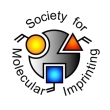Authors: Hebert B, Meador DS, Spivak DA
Article Title: Scalemic and Racemic Imprinting with a Chiral Crosslinker.
Publication date: 2015
Journal: Analytica Chimica Acta
DOI: 10.1016/j.aca.2015.08.001
Alternative URL: http://www.sciencedirect.com/science/article/pii/S0003267015008636
Abstract: The development of molecularly imprinted chiral stationary phases has traditionally been limited by the need for a chiral pure template. Paradoxically, availability of a chiral pure template largely defeats the purpose of developing a chiral stationary phase. To solve this paradox, imprinting of scalemic and racemic template mixtures was investigated using both chiral (N-α-bismethacryloyl-L-alanine) and achiral (N,O-bisacrylamide ethanolamine) crosslinkers. Imprinting of scalemic mixtures provided polymers capable of partial separation of Boc-tyrosine enantiomers with virtually the same results when using either the chiral or achiral crosslinker. However, the chiral crosslinker was required for chiral differentiation by the racemic imprinted polymers which were evaluated in both batch rebinding and chromatographic modes. Batch rebinding analysis revealed intersecting binding isotherms for the L- and D-Boc-tyrosine, indicating bias for the D or L enantiomer is concentration dependent. Partial chromatographic separation was achieved by the racemic imprinted polymers providing variable D or L bias in equal probability over multiple replicates of polymer synthesis. Correlation of enantiomer bias with the batch rebinding results and optimization of HPLC parameters are discussed
Author keywords: Molecular imprinting, chiral crosslinker, chiral selectivity, enantiomeric excess, scalemic, racemic templates, chiral stationary phase


Join the Society for Molecular Imprinting

New items RSS feed
Sign-up for e-mail updates:
Choose between receiving an occasional newsletter or more frequent e-mail alerts.
Click here to go to the sign-up page.
Is your name elemental or peptidic? Enter your name and find out by clicking either of the buttons below!
Other products you may like:
 MIPdatabase
MIPdatabase









